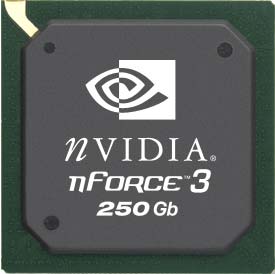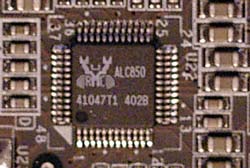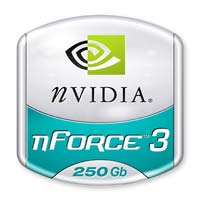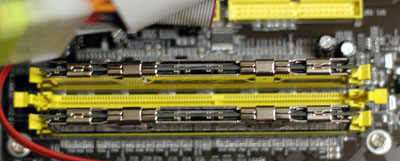DFI LANParty UT nF3-250Gb: Overclocker's Dream
by Wesley Fink on September 8, 2004 12:05 AM EST- Posted in
- Motherboards
Basic Features: DFI LANParty UT nF3 250Gb
| DFI LANParty UT nF3 250Gb Motherboard Specifications | |
| CPU Interface | Socket 754 Athlon 64 |
| Chipset | nVidia nForce3-250Gb |
| Bus Speeds | 200MHz to 456MHz (in 1MHz increments) |
| PCI/AGP Speeds | 66MHz to 100MHz (in 1MHz increments) |
| Core Voltage | Auto, 0.8V to 1.55V in .025V increments plus Vid Special multiplier of 4%, 10%, 13%, 23%, 26%, 33%, 36% - TO 2.1V |
| DRAM Voltage | Auto, 2.5V to 3.1V in 0.1V increments (to 3.3V with future BIOS) |
| AGP Voltage | 1.5V-1.9V in 0.1V increments |
| Chipset Voltage | 1.6V-1.9V in 0.1V increments |
| Hyper Transport Ratios | Auto, 1x, 1.5x, 2x, 2.5x, 3x, 4x, 5x |
| CPU Ratios | Auto, 4.0x to 20.0x in 0.5X increments |
| DRAM Speeds | Auto, 100, 120, 133, 140, 150, 166, 180, 200 |
| Memory Slots | Three 184-pin DDR Single-Channel Slots Unbuffered Non-ECC Memory to 2GB Total |
| Expansion Slots | 1 AGP 8X Slot 5 PCI Slots |
| Onboard SATA | 4-Drive SATA by nF3-250Gb |
| Onboard IDE | Two Standard nVidia ATA133/100/66 (4 drives) |
| SATA/IDE RAID | 4-Drive SATA Plus 4-Drive IDE can be combined in nVidia RAID 0, 1, 0+1, JBOD |
| Onboard USB 2.0/IEEE-1394 | 8 USB 2.0 ports supported by nF3-250Gb 2 1394A FireWire ports by VIA VT6307 |
| Onboard LAN | 1Gigabit Ethernet on-chip by nF3-250GB and Marvel PHY |
| Onboard Audio | Realtek ALC850 8-Channel with UAJ SPDIF coaxial in and out |
| BIOS | Award 8/27/2004 |

The single chip nVidia nForce3-250Gb is used for DFI LANParty UT. For more information on this chipset, you can refer to our launch articles for the chipset:
nForce3-250 - Part 2: Taking Athlon 64 to the Next Level
nForce3-250 - Part 1: Taking Athlon 64 to the Next Level
DFI has implemented the full feature set of the nVidia nForce3-250Gb, which includes on-chip Gigabit LAN, nVidia Firewall, and the nVidia "any-drive" RAID, which can control both the 4 SATA and IDE drives in a RAID configuration. On a board whose main purpose is to be the best overclocking board on the market, it is refreshing to see that DFI could still implement all of the unique features of the 250Gb chipset.
Since our test board was a production sample, we did not receive a full retail package because the packaging and manuals were still not available. DFI tells us that the shipping retail motherboard package will include:
- A user's manual
- Two round IDE cables
- One round floppy cable
- Two Serial ATA data cables
- One Serial ATA power cable
- One "nVRAID Driver" diskette
- One I/O shield
- One "Mainboard Utility" CD

DFI used just a short passive heatsink on the single chip nF3 250GB. The heatsink got very hot after running for a few hours, particularly during overclocking. While this didn't appear to limit our overclocks, the chipset did get hot enough that you should consider replacing the small chipset heatsink with a larger passive heatsink or an active heatsink and fan. DFI uses standard mounting holes for the heatsink, so replacement should be fairly easy. Fortunately, there is also a fan header conveniently located near the chipset. While there were no crashes from the heat and overclocks were still record-setting, we wondered how much higher we might have gone with better chipset cooling.

Many of the second generation boards have chosen the Realtek ALC850 7.1 audio chip. DFI also uses the 850 and provides a full implementation of audio jacks and SPDIF connections to fully support the audio chip. This 8-channel audio codec is fully AC '97 2.3 compliant and features 16-bit 8-channel audio and auto-jack sensing with support for a full range of analog and digital IO. A wide range of sound standards are supported including:
- EAXTM 1.0 & 2.0 compatible
- Direct Sound 3DTM compatible
- A3DTM compatible
- I3DL2 compatible
- HRTF 3D positional audio
- SensauraTM 3D Enhancement
You can find more information on the recently released ALC850 at Realtek product information.

DFI supports the ALC850 with 6 audio mini jacks plus both coaxial SPDIF in and out connectors on the back IO panel. Optical audio connections are not supported. IO also includes PS2 mouse and keyboard, parallel, 1 serial, 1 standard Firewire (IEEE1394), 4 USB, and a Gigabit Ethernet.

The DFI nF3 250Gb fully supports nVidia "Any Drive" RAID. Any of the standard 4 IDE drives or an additional 4 SATA drives can be combined in a Raid 0 (striping), Raid 1 (Mirroring), or Raid 0+1 array. This is the most flexible RAID arrangement that we have seen built into any chipset.

On-chip Gigabit LAN is built-in with the nF3-250Gb and runs completely independently of the PCI bus. The Marvel PHY (Physical Layer) chip provides the interface for direct communication of the LAN to the chipset. This ensures that the LAN is always capable of providing the fastest throughput possible with your LAN connections.

Three DIMM slots support up to 2GB of up to DDR400 memory in a Single-Channel memory configuration.
If you are wondering why this performance board does not use the Socket 939 chipset with Dual-Channel memory, we would have to guess that it is about performance, cost, and availability. First, the Athlon 64 is not as dependent on memory bandwidth as Pentium 4 solutions. The single-channel socket 754 is just as fast as the dual-channel Athlon 64 chips in many applications. Second, the only Athlon 64 chips currently available for Socket 939 are pretty expensive and overclockers always enjoy pushing cheaper parts to their absolute limits. Third, cheaper Socket 754 parts are available all the way from the $120 Sempron 3100+ to the 3700+ 2.4GHz. This covers the full range of speeds available for Athlon 64.
DFI tells us that there will be a Socket 939 board in the LANParty series a bit later, but they believe that the biggest demand for an overclocking board right now is in Socket 754.










54 Comments
View All Comments
leexgx - Thursday, November 4, 2004 - link
the 939 AMD cpu will only be my upgrade path (unless i wait and some thing els comes out)my NF7-S v2.0 mobo has 2x faster mem speed then an s754 so in my view it be an Downgrade if i whent to it
my upgrade (dream at the mo :)
MSI K8N Neo2 (waiting for the nForce4 ultra to comes out) or something like it (but nf4 chip)
3500+ 939 (mite even wait for the 4000+ or the FX55 to come down in price)
2x 512 ddr 400 OCZ low latency stuff (or other stuff that mite run better then OCZ)
MiLaMber - Sunday, October 31, 2004 - link
HmmWhy on earth bring out this board for s754 NOW??
Do they honestly think ppl would have waited this long for s754? They SHOULD have made it s939.
I see this as lost revenue for DFI.
Fantastic board yes, but for those who are looking to currently upgrade, will there be many who opt for this baord over a s939?
I wish they had brought it out as a s939, as I would forget about buying an MSI K8N Neo2 in an instant.
Its all well and good having the best board, but you need to have some savvy to, and think about when the introduction of your board will result in the greatest revenue!
And thats just plain common sense.
tchuyev - Monday, October 25, 2004 - link
So... using 3 SATA disks in a RAID0 array (using SATA ports 2 & 3 + 1 or 2, along with 2 * 512 OCZ PC-4200), I can't overclock the motherboard any higher than 240 FSB, right ?Using both the nForce & Marvell SATA controlers with the same 3 SATA disks on a RAID0 array : is it more likely to cause a performance drop - comparing to 2 disks on ports 3 & 4 - more than anything else ?
In my case, wouldn't it be thus better to go for a Silicon Image 3114r instead, like on the Asus K8N-E Deluxe ?
Thanx a bunch ;)
GGiovanni - Saturday, October 9, 2004 - link
Is there any detail regarding the memory DDR616 bandwidth since this mb uses on single channel setup? I'm interested on bandwidth when oc , not only low CAS o other tweaks.Happy Buddha - Tuesday, September 21, 2004 - link
Opps! Looks like I have double personality and they bot want to know what RAM have you bought.=:p
Happy Buddha - Tuesday, September 21, 2004 - link
#47 - What RAM stick are you using?!? I have never seen a review on the Net that was able to pull these timing @245mhz Fsb..Happy Buddha - Tuesday, September 21, 2004 - link
#47 - What RAM Stick are you using? I have never seen any review out there that have been able to push these timing at 245Mhz FSB...eva2000 - Monday, September 20, 2004 - link
awesome review.. just got my DFI Lanparty UT NF3-250Gb 3 days ago and posted results at http://i4memory.com/showthread.php?t=142 with my AMD64 3400+ @ 11x 245HTT = 2695mhz and ram at 245mhz 2-2-2-6 1T !JustAnAverageGuy - Sunday, September 12, 2004 - link
"With our stock 3200+ and ATI Radeon 9800 Pro, the DFI is one of the better 2nd generation 754 boards. Standard performance tests demonstrate the DFI LANParty UT is very competitive with other recent Athlon 64 boards in Direct X 9 games, which is all we would expect. UT2004 and Far Cry include results from Socket 939 and Intel 775 for comparison. Since both the 939 and 775 results were with faster CPUs running an nVidia 6800 Ultra AGP 8X/PCIe, it is remarkable that the scores are as close as they are."I nearly missed that paragraph. Perhaps you should make it stand out a little better?
Cygni - Thursday, September 9, 2004 - link
If it does come in around that price point, DFI will move ALOT of these things...